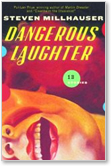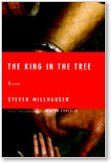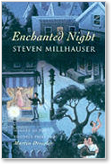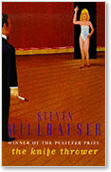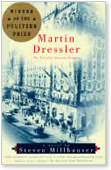Steven Millhauser
posted Jun 24, 2008
Critics are often too quick to call writer “conjurers,” but Steven Millhauser is one who merits the label. His stories and novels deftly combine the realistic with the fabulous, and hold us spellbound by straying neither into the dully everyday, nor the unbelievably fantastic. So earlier this year, we were thrilled to be among the first to read his new collection Dangerous Laughter—and, more recently, to have the following virtual sitdown with the man himself:
 * * |
Dangerous Laughter’s first story is “Cat ‘n’ Mouse,” an “Itchy and Scratchy”-style sketch that’s at once funny, violent, and puzzling, and ends with the mouse using a handkerchief to wipe its cat antagonist into nothingness, then doing the same to itself. Did you write it intending that it serve to introduce the collection?
When I write a story, it’s with no thought of a collection. It’s with no thought of anything at all except sentences that aren’t yet right. Gradually, over the years, stories accumulate. I notice it with a sort of surprise. In this case, ten years passed. Slowly, in my mind, stories began to drift together, to form separate groups. But I like symmetry—and there were thirteen stories. It struck me that maybe one story, if it touched on all the others, could serve as a kind of prologue. As I thought about “Cat ‘n’ Mouse,” I saw that it has a vanishing theme, as in the first set of stories, and an architectural theme, as in the second set, and even an historical theme, as in the third set—historical in the sense that the story pretends to resurrect an historical artifact, a mid-century cartoon.
But more than all that, I miss opening cartoons at the movies. Where have they gone, the opening cartoons of my childhood? I seized the chance to start my collection with one. Life is better with an opening cartoon.
Your work has always had a fabulist tinge, and Dangerous Laughter’s stories are no exception. The magic handkerchief-wielding mouse is a case in point; another is the paintings that come to life, in “A Precursor of the Cinema.” What continues to attract you to messing with reality?
I mess with reality in the name of reality. Another way of putting it is that I don’t mess with reality. I mess with the assumption that reality is perfectly captured by middle-of-the-road realist fiction. I’d argue that the conventions of the realist story don’t begin to do justice to the blazing thing that deserves the name of reality. This has nothing to do with a sneer at past masters. I revere the brilliant realist masters of the nineteenth and early twentieth centuries, and I read them obsessively. But to write Chekhov-like stories one hundred years after his death strikes me as questionable.
Dangerous Laughter is broken up into three sections, the first of which (“Vanishing Acts”) consists of stories told by narrators who serve more as witnesses to events than key participants. Did you consciously choose to use the same narrative strategy for all these stories, or did you notice only later that you told them all in the same way?
The stories were written over many years, without any thought of combining them in a particular way. I hadn’t thought of what you’ve noticed until this second. I find it interesting, but I wouldn’t make too much of it.
You’ve used first-person plural narrators before, and do so in the new collection as well. What advantages does this strategy bring? Are multiple “I”s difficult to keep track of? And why the sudden transition from a “we” to an “I” narrator in Dangerous Laughter’s “The Other Town?”
One interesting fact about “we” is that it’s rarely used. The mere idea that it isn’t “I” or “he” is wonderfully liberating. The fictional possibilities are enticing. “We” is an adventure.
The main use of “we” is that it represents the voice of a community. The speaker is multiple. This means that you can’t tell the usual kind of story, about a favored protagonist. The slant is radically different. But “we” is also paradoxical, since how is it possible for a single voice to express the thoughts of a group? I exploit the paradox by occasionally permitting an “I” to break free from the “we” and to present itself as a personal voice within the “we.” In a story like “The Other Town,” I begin with the group but allow the individual narrator to appear when his thoughts are so complex or personal that they clearly attach to a single person and not to a community. The shifting back and forth, which can take place suddenly, is one of the exciting possibilities in a story narrated by a “we.”
The opening image in “The Disappearance of Elaine Coleman” is a familiar one: yellowed “missing” posters on glass doors at the post office, on telephone poles, on the windows of the CVS…. In writing the story, were you inspired by a “real” image—that is, by seeing such posters? How did Elaine Coleman come about (and disappear)?
I’m pleased you think the story was inspired by a “real” image. It wasn’t. Who knows where stories come from? Not me. I do know that I often think back to grade school or high school and dimly recall people who were in my classes but whom I didn’t know, didn’t think much about. They have a kind of half-existence, a ghost-existence, in my mind. Everyone carries around these ghosts. At some point I became haunted by the idea of such a person, who, always ignored, would gradually fade away. The vision of a fading person became connected to my old interest in the locked-room mystery. Somehow a story emerged. The images you mention are in the world, and I used them for my own ends.
Your opening lines are so definitive that often, after reading one of your stories all the way through, one can’t possibly think of a better way to have started it. A case in point is “The Tower,” which begins, “During the course of many generations the Tower grew higher and higher until one day it pierced the floor of heaven.” How important is the opening line of a story? Do you find yourself working on it until you think you’ve gotten it right, or do you, during the revision process, sometimes discover that the best opening line is on the third page of your first draft?
The opening line of a story is absolutely crucial. It’s so crucial that the mere thought of it ought to terrify any writer into a lifetime of silence. That first sentence has to excite me into the rest of the story. It has to be so seductive that I can’t bear not to continue. I work on the opening sentence relentlessly, in my mind, and can’t begin writing until I have one I believe in—one that thrusts me as if violently into the story. I revise fanatically, but I don’t discover the first sentence on page 3. If I did, I’d throw the whole story away.
That said, it’s also true that the opening line isn’t the opening line. The first words a reader sees in a story come in the title. The true opening line of a story is the title. The apparent opening line is actually the second line. What this means isn’t simply that the title is as crucial as the opening sentence, but that the opening sentence plays off the title. Whenever I hear that a writer chooses a title after the story is done, I ‘m astonished, baffled—for me, that would be like leaving out the name of the main character and deciding on it at the end. Think of how much information you get from a title like “Death in Venice.” The first sentence takes place in Munich, but already you know that the story is going to Venice. You know that a death will take place. Death infects the opening sentence.
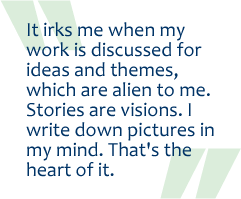
In an ideal story, never yet written, all you’d need would be the title and the first sentence. The rest would be superfluous.
Books and stories are often classified as “character-driven” or “plot-driven.” Your work doesn’t really fit into either category, and as often as not, critics discuss your themes, and the ideas you treat, instead of your characters and plots. As you write, how cognizant are you these aspects of your work?
If I have an idea that interests me, I write an essay. It’s happened maybe five times in the course of my life. Clearly, I don’t have many mental events that I dignify with the name of ideas. It irks me when my work is discussed for ideas and themes, which are alien to me. Stories are visions. I write down pictures in my mind. That’s the heart of it. Of course, I’m not mindless, not an idiot, and my visions are shaped by shadowy thoughts that some people like to call ideas or themes. But nothing interests me except the vision itself.
The story “Dome” is a prime example of a story that seems to be idea-driven. No doubt many readers would like to know what it “means,” and critics have already speculated about this. Are you amused by this speculation, or is it best to avoid it altogether?
I understand why “The Dome” might appear to be an idea-driven story. The narrator has plenty of ideas, as my narrators often do. But what excited me into writing the story was simply the vision of a dome, growing larger and larger, until it covered the entire world. That’s what I mean by a picture. Maybe it should be called a pattern. If so, it’s a pattern deeply embedded in my imagination, a pattern that continually reappears in my work—a simple thing gets larger, more complex, more dangerous or questionable. If someone tells me that such visions or patterns apply to the world, I find that interesting, even fascinating. If someone asks me what I mean by a story, I look at my watch and say I have a pressing engagement.
It some respects many of the ideas and themes you touch on in your debut work, Edwin Mullhouse, are as of-the-moment now as they were then. That said, what do you write about now that you didn’t, or simply couldn’t have, forty years ago?
An impossible question. I like impossible questions. I spend very little time brooding over the relation of past work to present work. When I write, I write for the first time, the only time. When I’m done, I’m through writing forever. Then it begins all over again. Someone with a more rational relation to my work than I have could probably answer this question for you. I suspect that a novella like “Revenge,” in The King in the Tree, would have been impossible for me to imagine in my twenties, when I was writing Edwin. Really, this is the kind of question you ought to ask a writer after he’s dead. I’ll talk to you then.
You've spent the better part of the past few decades teaching creative writing. Some would argue that the teaching of creative writing has become institutionalized to the detriment of literature. Is it true that you were quite hesitant to go into teaching? How do you view your teaching experience now? Does it affect your own writing?
I was extremely hesitant to go into teaching. I didn’t teach my first writing course until I was over forty. By then, I knew who I was. I was a writer, and nothing but a writer. Whatever I did wouldn’t affect that. In my twenties, I would have hanged myself rather than teach a class in writing. I would have been afraid of damaging myself in some fatal way. After forty, it was all right. And I like my students. My own writing? That’s a matter of inducing in myself a waking dream and writing down what I see. Teaching has nothing to do with it.
You’ve said that reading fiction should be “an adventure or it’s nothing… [and] if what I write doesn‘t lead a reader into the woods, away from the main path, then it’s a failure.” Do you look at writing the same way? That is, do you let a story lead you where it will, and treat the process of writing as one of discovery? Or do you tend to follow a fixed plan, and seek simply to flesh it out into a text?
The idea of letting a story “lead me where it will” strikes me as ludicrous. It implies a naïve conception of the artist as a wide-eyed child skipping in a field, uninhibited by any constraints. A fixed plan, on the other hand, sounds to me deadly. Those are surely not the only choices. I spend a long time not writing, not permitting myself to write, crushing down the desire to write, while I turn material over in my mind—perhaps that’s the uninhibited part—and by the time I allow myself to write, I have a kind of fluid plan, capable of change, even radical change, but helpful as I make my way into the dark.
As an author who’s written novellas, novels, and of course short stories, which form is your favorite? And can you tell us what your readers can expect to see from you in the near future?
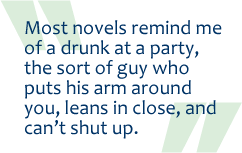
My heart lies in short forms, in stories and novellas. I don’t reject novels. But I’m suspicious of them, those big noisy things that don’t know how to stop. Most novels remind me of a drunk at a party, the sort of guy who puts his arm around you, leans in close, and can’t shut up. Novels are the skyscrapers of literature, the Wal-Marts of literature. It’s a particularly American obsession: size as power. It’s as if a work of literature, in America, is supposed to be the size of the entire country. This isn’t to say that the short story doesn’t have an ambition, an aggression, of its own.
As for the future—what I like about the future is that it’s unknown.
© 2008 failbetter LLC · all rights reserved





